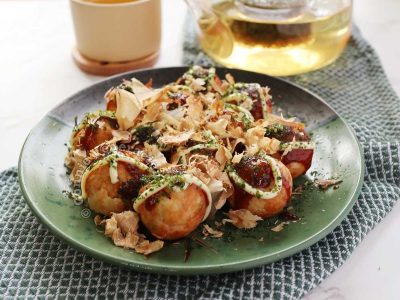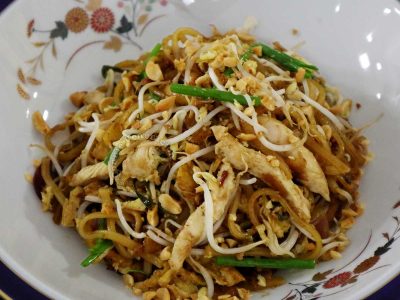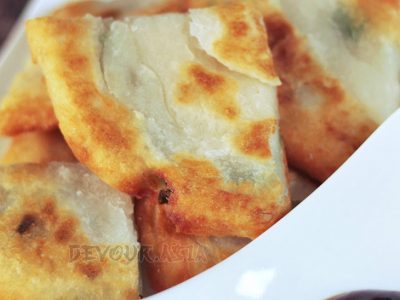Warorot Market in Chiang Mai is closed at night but the streets surrounding it were buzzing with fruits, flowers and food when we were there in January this year. It was from one of the food stalls there that we had our first experience of Thai coconut custard pancakes or khanom khrok (yes, it turns out that the correct spelling includes “h”) as they are called by the locals.

Just how small are these pancakes? In diameter, a bit larger than takoyaki. There is a special pan in which they are cooked — cast iron and similar in appearance to takoyaki pan but the indentations are wider and shallower. Similar to the Vietnamese banh khot pan too.
We were not able to buy the proper pan for making Thai coconut custard pancakes at home so we had to make do with our takoyaki pan. As a result, our pancakes were smaller but thicker at the center. We have a non-stick takoyaki pan. While we almost always brush the indentations with oil or butter before cooking anything in it, in the case of these pancakes, it wasn’t necessary to use oil.
Fresh coconut cream was used and its natural oil content was sufficient to make sure that the pancakes did not stick to the pan. I have no idea if using canned coconut cream or coconut powder will yield the same result. I suggest you make two or three pancakes first and observe if oil is rendered during cooking. If not, brush the indentations of the pan with oil.
Thai Coconut Custard Pancakes (Khanom Khrok)
Recipe by
Equipment
- Takoyaki pan
Ingredients
For the shell
- 50 grams cooked jasmine rice cooled
- 30 grams palm sugar
- 50 grams rice flour (not glutinous)
- ¼ cup thick coconut cream
- ¼ cup thin coconut milk
- ¼ cup grated mature coconut
- 1 pinch salt
For the custard filling
- 1 cup thick coconut cream
- 1 tablespoon palm sugar
- ¼ teaspoon salt
- 2 tablespoons rice flour (again, not glutinous)
For the toppings
- ¼ cup sweet corn kernels (canned is okay)
- ¼ cup finely sliced scallions
Instructions
Make the shell batter
- Place all the ingredients for the shell in a blender and pulse several times until no large pieces remain but the mixture is still a bit chunky. Transfer to a bowl, scraping off the sides of the blender pitcher.
Make the custard filling
- In a bowl, mix all the ingredients for the filling until smooth.

Cook the pancakes
- Heat a takoyaki pan on the stove top. Keep the temperature on medium.
- Pour a teaspoonful of the shell batter into each indentation. It is important to stir the batter before in the bowl each time you scoop out a teaspoonful to make sure that the solids do not settle at the bottom of the bowl.

- Pour a teaspoonful of the custard filling on top of the shall batter. Again, it is the better practice to stir the custard filling in the bowl each time you take a teaspoonful to prevent the rice flour from settling at the bottom.
- When the pancake is bubbly along the edges, add a pinch or two of your preferred topping.
- When the edges of the pancakes are browned, take a skewer to tilt each pancake one by one and, with your other hand, use a spoon to scoop out the pancake and move it to a cooling rack.

Serve the Thai coconut custard pancakes
- These pancakes are best while hot. But be careful because the custard can scorch your mouth. So, wait a minute or so after they are removed from the pan before popping them into your mouth.


